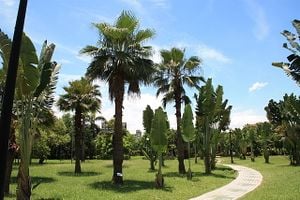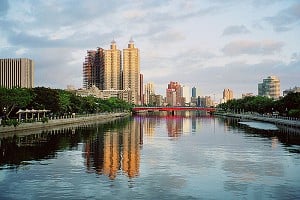The aim of this page is to recognise, celebrate and encourage the self-empowerment of community agency networks (CANs) and community groups across Taiwan.

- A Strong Democracy Is a Digital Democracy, Oct 17, 2019...[1]
- Voting is just "entry-level democracy", says Audrey Tang. After that, open data and deliberation. Feb 6, 2019...[2]
Open spaces[edit | edit source]
Taiwan has 9 national parks and 1 national natural park, which are administered by the Ministry of the Interior.
National parks of Taiwan are protected spaces for the nature, wildlife, and history under their current jurisdiction. The national parks cover 7,489.49 square kilometres (2,891.71 sq mi). The 3,103.76-square-kilometre (1,198.37 sq mi) total land area constitutes around 8.6% of the entire land area of the country. After World War II, calls for protecting the natural environment were met with opposition due to the prioritization of economic development. The National Park Law was passed in 1972, and the first national park was established in 1984.
National parks should not be confused with national scenic areas. The national scenic areas are administered by the Tourism Bureau of the Ministry of Transportation and Communications. There are also different philosophies that govern the development of the two types of areas. For a national park, the emphasis is on the preservation of natural and cultural resources, with development for human utilization being a secondary priority.
Trees, woodland and forest[edit | edit source]
The period 1995–2015, saw major afforestation made and forested land reached its peak at 67% in 2010. Most of the afforestation were made on former agricultural land. Since 2008, companies, individuals and government bodies have jointly planted more than 230 km2 of trees. Following this period the primary challenge facing forests in Taiwan is illegal logging. W
Community involvement[edit | edit source]
gOv[edit | edit source]
Policymakers have been using open-source tools, including Pol.is, to crowdsource feedback for policies on ride-hailing apps, among other things. Another social movement, driven by the same tools and decentralized organizing methods as the Sunflower Movement, resulted in the country deciding to shut down all of its nuclear power plants by 2025.
With the election of President Tsai Ing-wen last year — a social progressive who vowed a "new era" of democracy — Taiwan has become a leader in tech policy and transparency. In fact, one of the leaders of the digital movement, Audrey Tang, was appointed head of a new council on digital policy, and describes herself as a "hacker minister."
At the forefront of Taiwan's digital movement is the unique, open-source community called g0v. Initially they came to prominence for creating alternative versions of Taiwanese Government websites, replacing the.gov with a.g0v and making data about ministries, budgets, and finances more transparent to Taiwanese citizens.[3]
Tang's first initiative, the g0v project, was open source, in line with Tang's principles, and very popular, accessed millions of times each month. W
vTaiwan[edit | edit source]
Another initiative, vTaiwan, uses social media paradigms for citizens to create digital petitions. Those with 5,000 signatories are brought to the premier and government ministries to be addressed. Changes implemented through this system include access to income tax software for non-Windows computers, and changes to cancer treatment regulations. The Taiwanese parliament complained that citizens had better access to influence regulation than they did as legislators. W
The vTaiwan process was established by a civil society movement called g0v, at the invitation of the Taiwanese Minister for Digital Affairs. It followed g0v's major role in the 2014 Sunflower Movement protests; started over a controversial trade agreement with China.
The process was designed as a neutral platform to engage experts and relevant members of the public in large-scale deliberation on specific topics.
The process itself is designed to facilitate constructive conversation and consensus-building between diverse opinion groups. It does this by creating several stages, including an initial 'objective' stage for crowdsourcing facts and evidence, and a 'reflective' stage using mass deliberation tool Pol.is, which encourages the formation of 'rough consensus'. Finally, key stakeholders are invited to a live-streamed, face-to-face meeting to draw up specific recommendations.
Facilitators and g0v volunteers guide people through each stage using different web tools, including timelines, email updates and access to clear information. In a radical approach to transparency, the entire consultation is continuously summarised, transcribed and published in an open, structured and searchable format.
vTaiwan's achievements to date include: a crowdsourced bill successfully passed through parliament on Closely Held Company Law; the resolution of a disagreement between civil society activists on the topic of internet alcohol sales; and the ratification of several items on ridesharing (Uber) regulations.[4]
- vTaiwan project page, added 10:24, 8 February 2022 (UTC)
- Taiwan Grassroots Digital Democracy That Works, creative commons licensed pdf, date not found, available via radicalxchange.org
Community energy[edit | edit source]
Solar power in Kaohsiung City[edit | edit source]

Kaohsiung City, well-known for its sunny weather and water resources, is located in southern Taiwan. Over the years, Kaohsiung Mayor Chu Chen and former Kaohsiung County Commissioner Chiu-Hsing Yang were pushing to make Kaohsiung a more environmentally friendly and sustainable city.[5]
Renewable energy in Taiwan[edit | edit source]
Renewable energy in Taiwan contributed to 8.7% of national electricity generation as of end of 2013. The total installed capacity of renewable energy in Taiwan by the end of 2013 was 3.76 GW.
As of 2021, Taiwan had set a target to generate 20% of its energy from renewable sources by 2025, an increase from the 5% achieved in 2020. This plan is part of a broader policy to reduce coal usage, enhance the use of liquefied natural gas (LNG), and transition towards a "nuclear-free homeland." The strategy includes adding 5.7 GW of offshore wind power and increasing solar energy capacity to 20 GW by 2025.
Wind power in Taiwan[edit | edit source]
Wind power is a major industry in Taiwan. Taiwan has abundant wind resources however a lack of space on land means that most major developments are offshore.
Cycling activism[edit | edit source]
YouBike, originally Taipei Bike Sharing System, is a public bicycle sharing service offered by the Taipei City Department of Transportation in a BOT collaboration with local manufacturer Giant Bicycles. As of 26 May 2016, service stations in the bike system are available in Taipei City, New Taipei City, Taoyuan City, Hsinchu County, Hsinchu City, Hsinchu Science Park, Miaoli County, Taichung City, Chiayi City, Tainan City, Kaohsiung City, and Pingtung County. In Taipei City, rental is NT$5 for the first 30 minutes of use and adopts progressive tolls from NT$10 to NT$40 thereafter. No other fee, such as yearly deposit, is required. There is a 15-minute renewal restriction period at the station to which the bike was returned.
In 2014, the system saw 22 million rentals, double the 11 million rentals the previous year, with 196 rental stations circulating 6,046 bikes. As of February 2023, there are a total of 1,582 YouBike 1.0 rental stations and 5,246 YouBike 2.0 rental stations across Taiwan, with a total of 653 million rentals.
Sustainable transport activism[edit | edit source]
Kaohsiung car free days and a green transport program, World Streets, November 2009
News and comment[edit | edit source]
2017
Meet g0v, the Open-source, Digital Community Transforming Democracy in Taiwan, May 16[6]
2016
Return of the Bicycle Kingdom? How pavement cycling is transforming Taipei, Mar 15[7]
Environmental issues[edit | edit source]
Some areas in Taiwan with high population density and many factories are affected by heavy pollution. The most notable areas are the southern suburbs of Taipei and the western stretch from Tainan to Lin Yuan, south of Kaohsiung. By the late 20th century, Taipei suffered from extensive vehicle and factory air pollution, but after the government required mandatory use of unleaded petrol and established the Environmental Protection Administration in 1987 to regulate air quality, the air quality of Taiwan has improved dramatically. Motor scooters, especially older or cheaper two-stroke versions, which are ubiquitous in Taiwan, contribute disproportionately to urban air pollution. The Taichung Power Plant also contributes significantly to air pollution, producing more CO2 than the country of Switzerland.
Other environmental issues include water pollution from industrial emissions and raw sewage, contamination of drinking water supplies, trade in endangered species, and low-level radioactive waste disposal. Though regulation of sulfate aerosol emissions from petroleum combustion is becoming stringent, acid rain remains a threat to the health of residents and forests. Atmospheric scientists in Taiwan estimate that more than half of the pollutants causing Taiwan's acid rain are carried from China by monsoon winds.
About Taiwan[edit | edit source]
Taiwan, officially the Republic of China (ROC), is a country in East Asia. The main island of Taiwan, also known as Formosa, lies between the East and South China Seas in the northwestern Pacific Ocean, with the People's Republic of China (PRC) to the northwest, Japan to the northeast, and the Philippines to the south. It has an area of 35,808 square kilometres (13,826 square miles), with mountain ranges dominating the eastern two-thirds and plains in the western third, where its highly urbanized population is concentrated. The combined territories under ROC control consist of 168 islands in total covering 36,193 square kilometres (13,974 square miles). The largest metropolitan area is formed by Taipei (the capital), New Taipei City, and Keelung. With around 23.9 million inhabitants, Taiwan is among the most densely populated countries.
Taiwan has been settled for at least 25,000 years. Ancestors of Taiwanese indigenous peoples settled the island around 6,000 years ago. In the 17th century, large-scale Han Chinese immigration began under a Dutch colony and continued under the Kingdom of Tungning, the first predominantly Han Chinese state in Taiwanese history. The island was annexed in 1683 by the Qing dynasty of China and ceded to the Empire of Japan in 1895. The Republic of China, which had overthrown the Qing in 1912, took control following the surrender of Japan in 1945. The immediate resumption of the Chinese Civil War resulted in the loss of the Chinese mainland to Communist forces, who established the People's Republic of China and the flight of the ROC central government to Taiwan in 1949. The effective jurisdiction of the ROC has since been limited to Taiwan, Penghu, and smaller islands.
References
- ↑ nytimes.com
- ↑ The Alternative UK
- ↑ shareable.net, Nithin Coca, May 16, 2017
- ↑ vTaiwan, nesta.org.uk licensed under a Creative Commons Attribution-NonCommercial-ShareAlike 4.0 International License
- ↑ http://kcg.gov.tw/
- ↑ @Shareable
- ↑ The Guardian
